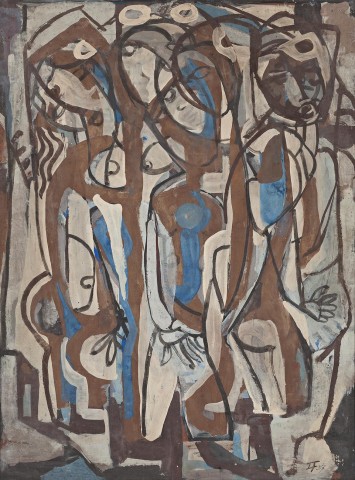SEA ANEMONES, 1957
IAN FAIRWEATHER
gouache on cardboard
95.0 x 71.5 cm
signed with monogram and dated lower right: IF 57
bears inscription on frame verso: ER CUPPAIDGE
Macquarie Galleries, Sydney
Russell Cuppaidge, Brisbane, acquired from the above May 1957
Sotheby’s, Melbourne, 10 April 1993, lot 230
Estate of Kerry Hill AO, Singapore
A View of Brisbane Collections, Queensland Art Gallery Society, Brisbane, 9 – 25 March 1979 (lent by Russell Cuppaidge) (label attached verso)
Ian Fairweather Tenth Anniversary Exhibition, Philip Bacon Galleries, Brisbane, 19 May – 14 June 1984, cat. 58 (illus. in exhibition catalogue) (label attached verso)
The singular vision of Ian Fairweather was the result of a varied series of influences and complex personal psychology. Born in Scotland and raised by aunts until the age of ten, he studied at London’s Slade School of Fine Art during the early 1920s, taking classes in Japanese and Chinese language at night. With a restless spirit, he travelled to Canada in 1928 to work as a farm labourer and the following year, sailed to Shanghai, spending several years in China, a country whose culture and history had a profound effect on the development of his art. In Melbourne in 1934 he met Jock Frater and George Bell, and exhibited his work at Cynthia Reed’s gallery in Little Collins Street, soon leaving again for the Philippines, then China and various destinations in South-East Asia in quick succession. Following his notorious attempt to sail to Timor on a raft made of old aircraft fuel tanks, Fairweather returned to Australia in mid-1953 and later that year, settled on Bribie Island off the coast of southern Queensland.
Fairweather had first visited Bribie Island in 1945 (drifting there by accident in a recently acquired lifeboat) and here, found a place where he could work consistently and relatively undisturbed for the rest of his life. Living in a pair of thatched huts that he had built using materials found in the nearby bush, and painting by the light of a hurricane lamp, his surrounds were primitive, but offered everything that Fairweather needed. While he relished the isolation of the Island and preferred not to engage with the art world in person, Fairweather exhibited regularly at Macquarie Galleries in Sydney – gallery directors Treania Smith and Lucy Swanton sending paper and other materials, as well as typically assigning titles to the paintings he shipped to them1 – and his work was both seen and admired by curators, critics, collectors and fellow artists alike.
Murray Bail has written that the ‘Post-Impressionist calm’ of Fairweather’s paintings from the 1930s and 40s belied the ‘economic and psychological hell’ he experienced during those decades.2 The relative tranquil stability of the late 1950s appears, counterintuitively, to have introduced a notable complexity to his work so that ‘it is the images which become tangled and fragmented; surfaces are unstable; a meditative virtue is made out of chaos’.3 Painted in 1957, Sea Anemones reflects this dynamism in its dense layering of painted lines and solid areas of colour. Numerous female figures stand side by side, searching for sea anemones, the lines describing their heads, limbs, breasts and hair, repeated and overlapped so that the fragmented elements – like the flickering lines of an early animation – combine in our imagination, forming a complete and fully resolved image. Areas of gouache in familiar tones of blue and brown have been applied with a broad brush and contribute to both the graphic and textural richness of the painting; patches of cream and strokes of vivid white allow linework below to show through. There is a strong visual and thematic link between this work and the majestic triptych, Anak Bayan, also dated 1957, which recalls Fairweather’s time in the Philippines and is one of the highlights of the Art Gallery of New South Wales’ collection of his paintings. With his distinctive monogram in the lower right corner, Sea Anemones exemplifies the confidence that distinguished Fairweather’s art during these years, as well as reflecting the tension between representation and the drive towards abstraction that was a constant within his oeuvre: ‘I don’t feel I am a complete abstractionist – I still like – perhaps mistakenly in this age of collectivism – to retain some relic of subjective reality’.4
1. Bail, M., Ian Fairweather, Bay Books, Sydney, 1981, p. 118
Murray Bail confirms however that this title was given by the artist rather than his gallery.
2. ibid., p. 128
3. ibid.
4. The artist quoted in ibid., p. 140
KIRSTY GRANT
